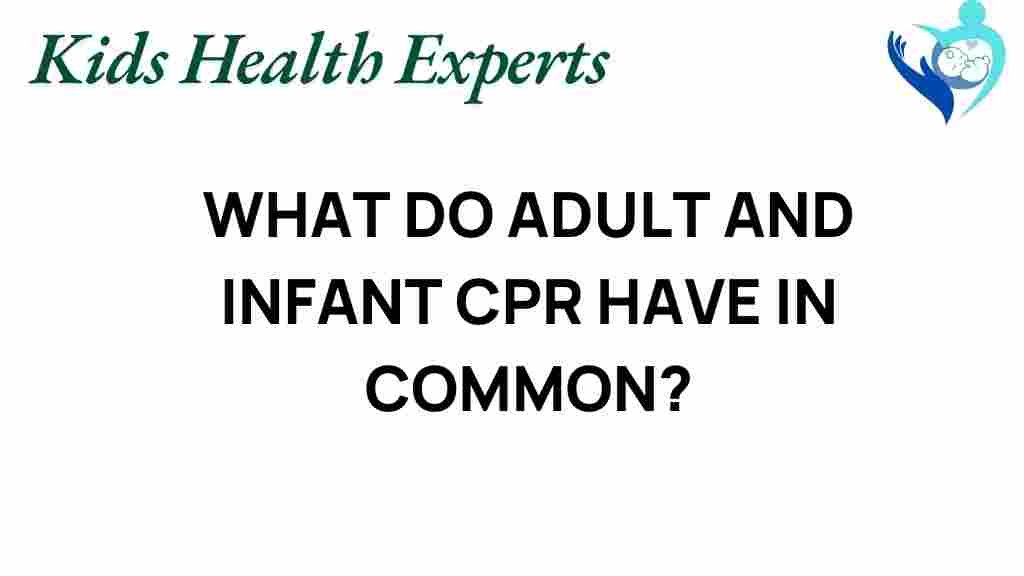Unraveling the Surprising Connections Between Adult and Infant CPR
Cardiopulmonary resuscitation (CPR) is a critical life-saving skill that everyone should learn, regardless of age. While the techniques for adult CPR and infant CPR differ in some aspects, the underlying principles of resuscitation are fundamentally the same. Understanding these connections can enhance our emergency response skills and enable us to save lives in various situations. This article explores the similarities and differences between adult and infant CPR, essential life-saving techniques, and best practices for effective health training and first aid.
Understanding CPR: A Quick Overview
CPR is an emergency procedure performed when someone’s heart stops beating or when they stop breathing. The goal of CPR is to maintain blood flow to the brain and other vital organs until professional medical help can arrive. There are two main components of CPR: chest compressions and rescue breaths. Although CPR techniques may vary for adults and infants, the core objective remains the same—restoring normal heart and lung function.
Why Learn Both Adult and Infant CPR?
Learning both adult CPR and infant CPR is essential for several reasons:
- Widespread Applications: You never know when you might encounter an emergency situation involving either an adult or an infant.
- Empowerment: Knowing how to perform CPR can empower you to act quickly and confidently during emergencies.
- Community Safety: By learning CPR, you contribute to the overall safety and health of your community.
The Steps of Adult CPR
Adult CPR typically follows these steps:
1. Assess the Situation
Before administering CPR, ensure the scene is safe. Check the person for responsiveness by shaking their shoulder and shouting, “Are you okay?” If there is no response, proceed to the next steps.
2. Call for Help
Dial emergency services immediately (e.g., 911 in the U.S.) or ask someone else to call while you attend to the person.
3. Check for Breathing
Look, listen, and feel for normal breathing for no more than 10 seconds. If the person is not breathing or only gasping, begin CPR.
4. Administer Chest Compressions
Place the heel of one hand on the center of the person’s chest and the other hand on top. Keep your elbows straight and use your body weight to compress the chest:
- Push hard and fast, at a rate of 100 to 120 compressions per minute.
- Compress the chest at least 2 inches deep.
5. Provide Rescue Breaths
After 30 compressions, give 2 rescue breaths:
- Open the airway by tilting the head back slightly.
- Pinch the nose shut, cover the person’s mouth with yours, and give a breath lasting about 1 second, watching for the chest to rise.
- Repeat for a second breath before resuming compressions.
6. Continue the Cycle
Continue the cycle of 30 chest compressions followed by 2 rescue breaths until emergency responders arrive or the person shows signs of life.
The Steps of Infant CPR
Infant CPR is similar but requires different techniques:
1. Assess the Situation
Check if the infant is responsive. Tap the bottom of their foot and shout to see if they respond.
2. Call for Help
<pIf the infant is unresponsive, call for emergency help or ask someone else to do so while you start CPR.
3. Check for Breathing
Observe the infant’s chest for any signs of breathing for about 10 seconds. If there is no breathing, proceed with CPR.
4. Administer Chest Compressions
For infants, use two fingers to perform compressions:
- Place your fingers just below the nipple line in the center of the chest.
- Compress the chest about 1.5 inches deep at a rate of 100 to 120 compressions per minute.
5. Provide Rescue Breaths
After 30 compressions, give 2 rescue breaths:
- Cover the infant’s mouth and nose with your mouth.
- Breathe into the infant gently, ensuring their chest rises.
6. Continue the Cycle
Continue the cycle of 30 compressions and 2 breaths until help arrives or the infant shows signs of life.
Key Differences Between Adult and Infant CPR
While the overall process of CPR is similar for adults and infants, there are key differences that are important to recognize:
- Compression Technique: Use two hands for adults and two fingers for infants.
- Compression Depth: Compress adults at least 2 inches deep; compress infants about 1.5 inches deep.
- Rescue Breaths: Cover the mouth and nose for infants; use the mouth only for adults.
Troubleshooting Tips for CPR
When performing CPR, consider these troubleshooting tips:
- Stay Calm: Panic can hinder your performance. Take a deep breath and focus on the task at hand.
- Call for Help Early: If you are alone, call for help before starting CPR, especially for infants.
- Know Your Limits: If you are untrained, perform hands-only CPR (chest compressions only) until help arrives.
Importance of Health Training in CPR
Health training is essential for effective emergency response. Here are several ways to get trained:
- Enroll in CPR Classes: Look for classes offered by organizations like the American Heart Association or the Red Cross.
- Participate in Workshops: Many community centers and hospitals offer workshops for first aid and CPR.
- Online Courses: Consider taking an online course for flexibility and convenience.
Regular training and refreshers are essential to keep your skills sharp and ready to use in an emergency. For more information on CPR training and resources, visit this resource.
Conclusion: Be Prepared, Stay Safe
Understanding the surprising connections between adult and infant CPR can empower you to act decisively in emergencies. By mastering these life-saving techniques, you not only enhance your emergency response skills but also contribute to a safer environment for everyone. Remember, whether it’s adult CPR or infant CPR, the ability to provide timely assistance can make all the difference. To truly be prepared, commit to ongoing health training and refresh your first aid skills regularly. Your knowledge and readiness could potentially save a life.
This article is in the category Care and created by KidsHealthExperts Team
